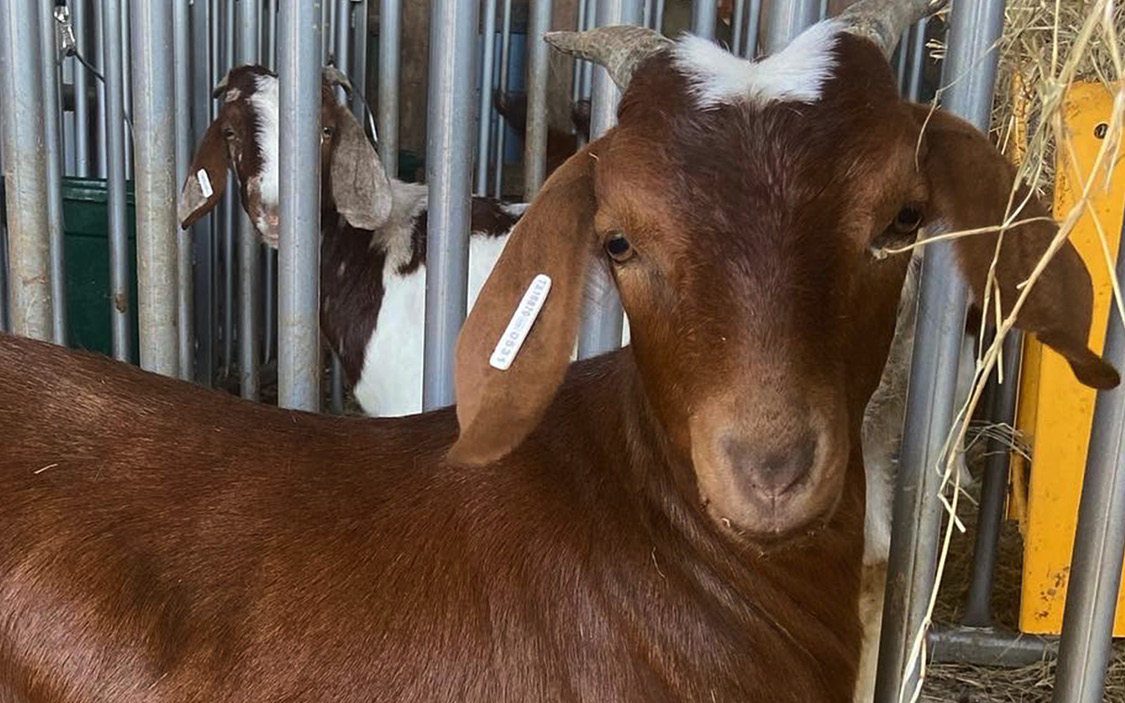Mineral Requirements and Impact on Dairy and Meat Goat Production
A healthy goat needs 15 essential minerals, 7 macrominerals, and 8 trace or microminerals. A balanced, loose, free-choice goat mineral is important for goat health. Using a salt block or a block of common livestock minerals is not ideal for goat health. A goat might need only ¼ to ½ ounce per day of a well-balanced mineral. On the other hand, it would need to consume 2 to 3 ounces per day of a salt block with trace minerals.
Minerals and vitamins are important components of dairy goat nutrition, and their requirements can be affected by the physiological growth state of the goat (growth, pregnancy, and lactation).
Macrominerals are usually reported on the feed tag on a percentage basis (%) and microminerals as parts per million (ppm), milligrams per kilogram (mg/kg), or grams per ton (g/ton). The main macrominerals needed in a goat’s diet are calcium, phosphorus, magnesium, sodium, potassium, sulfur, and chloride. The microminerals usually supplemented in goat rations are iron, copper, cobalt, manganese, zinc, iodine, selenium, molybdenum, and others. Tables 1a and 1b list acceptable levels of minerals to maintain a healthy goat.
Mineral |
Minimum (%) |
Maximum (%) |
|
Calcium (Ca) |
0.30 |
0.80 |
|
Phosphorus (P) |
0.25 |
0.40 |
|
Magnesium (Mg) |
0.18 |
0.40 |
|
Potassium (K) |
0.80 |
2.00 |
|
Sulfur (S) |
0.20 |
0.32 |
|
Sodium (Na) |
0.20 |
– |
|
Chloride (Cl) |
0.20 |
– |
Mineral |
Minimum (ppm) |
Maximum (ppm) |
|
Iron (Fe) |
50 |
1000 |
|
Copper (Cu) |
10 |
80 |
|
Cobalt (Co) |
0.1 |
10 |
|
Zinc (Zn) |
40 |
500 |
|
Manganese (Mn) |
0.1 |
3 |
|
Selenium (Se) |
0.1 |
3 |
|
Molybdenum (Mo) |
0.1 |
3 |
|
Iodine (I) |
0.5 |
50 |
Feeds are natural sources of minerals. Forages, depending on the soil pH and fertility, can be good sources of potassium and iron and are low in sodium. Cereals (concentrates or grains) are high in phosphorus and low in calcium and sodium. Legume seeds are richer in all minerals than forages and cereals.
Feeding calcium and phosphorus at a 2:1 ratio is recommended for better structural and bone strength, while other minerals are necessary for other systems like the nervous and reproductive systems.
Mineral deficiencies in dairy goats can have detrimental health effects. Calcium deficiency in dairy goats can lead to reduced milk production and cause parturient paresis (milk fever). Phosphorus deficiency can result in slow growth, an unthrifty appearance, and occasionally a depraved appetite. The calcium to phosphorus ratio should be maintained between 1:1 and 2:1 to avoid predisposition for urinary calculi.
Magnesium deficiency is associated with hypomagnesemia tetany (grass tetany). This condition is less common in goats than in cattle. Goats can compensate for magnesium deficiency by reducing the amount of magnesium they excrete (urinary and milk production).
Potassium deficiency is extremely rare in adult dairy goats because forages are usually rich in potassium. Deficiencies are usually observed when lactating does are fed a diet high in cereal grains. Potassium-rich diets could cause hypocalcemia in the herd.
Iron deficiency is seldom seen in mature grazing goats but could be observed in young kids due to low iron content in the milk. Iron deficiency can also be observed in animals that are heavily parasitized and is a sign of anemia.
Iodine deficiency in the soil can impact the amount in forages. Iodine deficiency results in an enlarged thyroid, poor growth, small and weak kids at birth, and poor reproductive ability.
Zinc deficiency results in parakeratosis, stiffness of joints, smaller testicles, and lowered libido. Excessive dietary calcium may increase the likelihood of zinc deficiency.
Copper deficiency may result in microcytic anemia, poor production, lighter or faded hair color, infertility, miscarriage, poor health, slowed growth, some forms of metabolic bone disease, diarrhea, and possibly a greater susceptibility to internal parasites. A low copper to molybdenum ratio or excessive dietary sulfur can cause a copper deficiency.
Selenium deficiency is associated with nutritional muscular dystrophy, retained placenta and metritis, poor growth, weak or premature kids, and mastitis. On the other hand, cobalt is known to aid in the production of red blood cells and improve fertility. Both copper and cobalt boluses are available for goats as a ruminal slow-release form of these microminerals; copper is used for parasite control and cobalt for reproduction.
Providing a free-choice mineral is recommended because forages might not have the concentrations required by goats at different growth stages. Soil quality and pH can affect the availability of macro- and microminerals absorbed by forages or browsing species. It is important to choose a loose mineral that is balanced. Goats have soft tongues, which makes it difficult to get enough minerals from a block or a bucket, while loose minerals can be easily licked up.
Salt (NaCl) is a necessary dietary component, and it is used as a carrier for trace minerals because goats have a clear drive for sodium intake. Salt blocks might not provide the required levels to maintain goat mineral requirements. They are designed to provide 25 to 50 percent of nutrient requirements.
It is important to determine which minerals your herd needs and design a forage-testing program that determines the nutritive value of the hay or forage being grazed. Tables 2, 3, and 4 provide a comparison of different commercially available goat mineral products such as loose minerals, salt block trace minerals, and supplemental mineral tubs. The reported mineral composition is based on the product label. Products may be consumed at different rates. Always consult the product label for the recommended consumption rates in ounces per head per day.
Loose minerals should not require additives (molasses, pelleted feed, etc.) or salt because they are salt-balanced to regulate intake. Providing additives with a loose mineral can dilute the mineral and vitamins and result in economic losses. On the other hand, salt blocks with trace minerals might increase water consumption because of their high salt content and might not be balanced to meet goat mineral requirements. Tubs are flavored with molasses and a combination of protein and minerals. These can alter daily consumption of the required supplementation and lead to possible overconsumption and toxicity.
To meet the mineral requirements of goats at different growth stages, select mineral products that provide a well-balanced mineral profile, reduce mineral losses during feeding, and are economically justifiable.
The ratio of calcium to phosphorus is an important factor because an imbalance of these two mineral concentrations can result in lower mineral bioavailability and other possible health issues. To reduce mineral losses, place mineral feeders under roofed areas and high enough to avoid fecal or dirt contamination. Place feeders in a dry area to avoid water accumulation. Provide several feeders so the whole herd has equal access to minerals (Figures 1 and 2). Monitor mineral feeders at least once a week and refill them as necessary.
Having inconsistent access to minerals will result in deficiencies and poor performance. Balanced supplementation with macro- and microminerals will reduce herd diseases, including parasitism and hoof problems, two of the main health issues goats face.
Vitamins
Fat-soluble vitamins A, E, D, and K are necessary for many functions within the animal and for the maintenance of herd health. Quantities are expressed as international units (IU, a unit used to measure the activity of vitamins, hormones, enzymes, and drugs).
Vitamins A and E have specific dietary requirements, whereas vitamin K can be synthesized in the rumen, and vitamin D can be synthesized by the skin when exposed to adequate sunlight. Vitamin A is needed for normal growth, reproduction, and maintenance of healthy epithelial tissue. Vitamin D is needed to build a strong, healthy skeletal frame. Vitamin E is an antioxidant that helps counteract harmful free radicals produced within the body. Vitamin E also helps maintain cell membrane and tissue integrity, also necessary for proper immune system function. A goat with a balanced ruminal microbiota can synthesize vitamin B in sufficient quantities to support metabolism. Vitamin C is synthesized in the liver, and it is essential for the goat’s immune system to work efficiently and protect them from diseases.
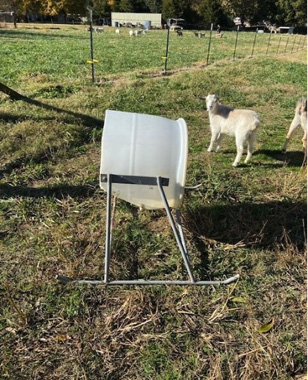
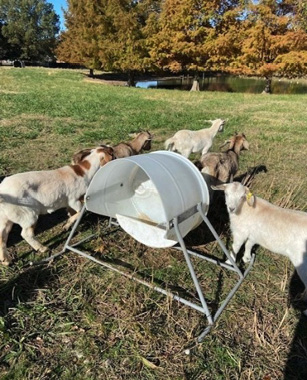
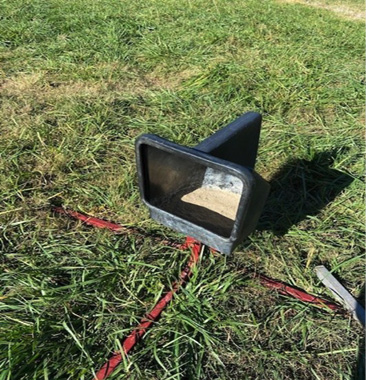
Figure 1. Examples of mineral feeders for goats. Photos courtesy Tapp Kikos & Livestock Equipment, Olive Branch, Mississippi.
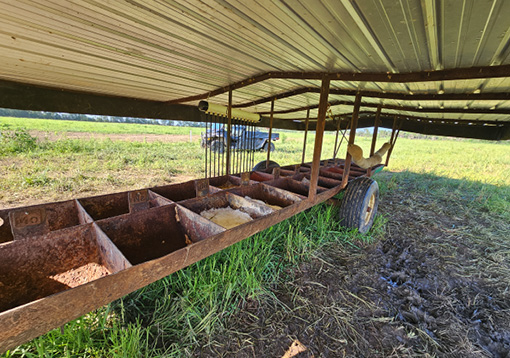
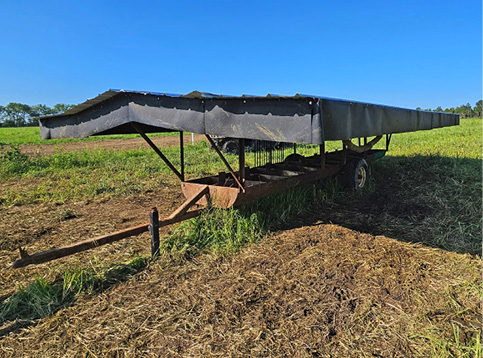
Figure 2. Free choice mineral feeders. Photos courtesy Magowah Ranch, Mississippi.
Nutritive Value |
DuMor Goat Mineral |
MannaPro Goat Mineral |
Purina Goat Mineral |
Sweetlix MeatMaker |
Redmond Goat Mineral Mix |
ZinPro 4-Plex C |
|
Crude Protein (CP, % Min) |
– |
4.00 |
– |
– |
– |
19.80 |
|
Ash (% Max) |
70.00 |
– |
– |
– |
– |
49.90 |
|
Macronutrient |
||||||
|---|---|---|---|---|---|---|
|
Calcium (Ca, % Min) |
10.00 |
16.00 |
15.30 |
14.00 |
3.50 |
– |
|
Calcium (Ca, % Max) |
12.00 |
19.20 |
18.36 |
16.80 |
4.00 |
– |
|
Phosphorus (P, % Min) |
6.00 |
8.00 |
8.00 |
8.00 |
1.50 |
– |
|
Potassium (K, % Min) |
1.00 |
1.50 |
– |
– |
0.03 |
– |
|
Sulfur (S, % Max)1 |
1.20 |
– |
– |
– |
0.07 |
– |
|
Magnegsium (Mg, % Min) |
.75 |
1.50 |
0.75 |
1.00 |
0.06 |
– |
|
Sodium (Na, % Min) |
– |
14.80 |
– |
– |
– |
– |
|
Sodium (Na, % Max) |
8.00 |
5.75 |
– |
– |
– |
– |
|
Salt (NaCl, % Min) |
16.00 |
12.00 |
27.50 |
15.00 |
76.00 |
– |
|
Salt (NaCl, % Max) |
19.20 |
14.40 |
32.50 |
18.00 |
81.00 |
– |
|
Micronutrient |
||||||
|
Cobalt (Co, ppm Min) |
– |
– |
– |
240 |
50 |
3600 |
|
Copper (Cu, ppm Min) |
850 |
1350 |
2500 |
1750 |
1000 |
1800 |
|
Copper (Cu, ppm Max) |
1200 |
1600 |
2700 |
1810 |
– |
– |
|
Iodine (I, ppm Min) |
100 |
– |
– |
450 |
2000 |
– |
|
Manganese (Mn, ppm Min) |
850 |
2750 |
– |
12000 |
2000 |
2860 |
|
Selenium (Se, ppm Min) |
20 |
12 |
50.00 |
50 |
60 |
|
|
Selenium (Se, ppm Max) |
24 |
14.4 |
– |
– |
– |
|
|
Zinc (Zn, ppm Min) |
1600 |
5500 |
4000.00 |
1200 |
3500 |
5150 |
|
Vitamin |
|
|||||
|
Vitamin A (IU/LB, Min)2 |
40000 |
300000 |
300000 |
300000 |
100000 |
– |
|
Vitamin D (IU/LB, Min) |
– |
– |
– |
– |
3500 |
– |
|
Vitamin D-3 (IU/LB, Min) |
15000 |
3000 |
3000 |
3000 |
– |
– |
|
Vitamin E (IU/LB, Min) |
100 |
400 |
2000 |
300 |
50 |
– |
|
Microorganisms |
||||||
|
Lactic Acid Bacteria (CFU/LB, Min) |
– |
1500000 |
– |
– |
– |
|
|
Total Microorganisms (CFU/LB, Min)3 |
22000000 |
– |
– |
– |
– |
1Parts per million (PPM); 2International units per pound; 3Colony forming units per pound
Nutritive Value |
New Country Organics |
Kalmbach 2:1 Goat Mineral |
Southern States Top Choice Goat Mineral |
Vigortone Goat Pro Mineral |
|
Crude Protein (CP, % Min) |
– |
– |
1.75 |
24.00 |
|
Crude Fat (CF, % Min) |
– |
– |
– |
0.50 |
|
Crude Fiber (CFI, % Min) |
– |
– |
– |
8.50 |
|
Macronutrient |
||||
|---|---|---|---|---|
|
Calcium (Ca, % Min) |
8.50 |
15.50 |
22.00 |
3.80 |
|
Calcium (Ca, % Max) |
9.50 |
18.50 |
– |
4.80 |
|
Phosphorus (P, % Min) |
4.00 |
8.00 |
6.00 |
2.0 |
|
Potassium (K, % Min) |
– |
1.00 |
– |
– |
|
Sulfur (S, % Max)1 |
– |
– |
0.25 |
– |
|
Magnegsium (Mg, % Min) |
3.00 |
1.50 |
3.00 |
– |
|
Sodium (Na, % Min) |
– |
– |
– |
– |
|
Sodium (Na, % Max) |
– |
– |
– |
– |
|
Salt (NaCl, % Min) |
11.00 |
18.50 |
21.00 |
18.90 |
|
Salt (NaCl, % Max) |
12.00 |
22.00 |
– |
22.60 |
|
Micronutrient |
||||
|
Cobalt (Co, ppm Min) |
– |
– |
15 |
|
|
Copper (Cu, ppm Min) |
– |
1450 |
– |
425 |
|
Copper (Cu, ppm Max) |
1800.00 |
1850 |
820 |
510 |
|
Iodine (I, ppm Min) |
– |
– |
40 |
– |
|
Manganese (Mn, ppm Min) |
– |
– |
2000 |
– |
|
Selenium (Se, ppm Min) |
– |
26 |
32 |
– |
|
Selenium (Se, ppm Max) |
– |
– |
– |
7000 |
|
Zinc (Zn, ppm Min) |
– |
7500 |
3000 |
1050 |
|
Vitamin |
||||
|
Vitamin A (IU/LB, Min)2 |
– |
300000 |
300000 |
52000 |
|
Vitamin D (IU/LB, Min) |
– |
45000 |
25000 |
– |
|
Vitamin D-3 (IU/LB, Min) |
– |
– |
– |
– |
|
Vitamin E (IU/LB, Min) |
– |
400 |
200 |
63 |
1Parts per million (PPM); 2International units per pound
Nutritive Value |
Producer’s Pride Trace Mineral Salt Block |
Premier1 Goat Trace Mineral Premix |
HerdLife Billy Block |
Goat Power Mineral |
|
Macronutrient |
||||
|---|---|---|---|---|
|
Calcium (Ca, % Min) |
0.12 |
3.5 |
0.46 |
12.5 |
|
Calcium (Ca, % Max) |
0.25 |
5.5 |
0.56 |
14.9 |
|
Phosphorus (P, % Min) |
– |
– |
0.50 |
6.95 |
|
Potassium (K, % Min) |
– |
– |
– |
1.45 |
|
Sulfur (S, % Max)1 |
0.05 |
11.00 |
0.05 |
– |
|
Magnegsium (Mg, % Min) |
0.10 |
– |
0.10 |
1.45 |
|
Salt (NaCl, % Min) |
96.00 |
– |
93.00 |
22.0 |
|
Salt (NaCl, % Max) |
99.00 |
– |
98.00 |
26.0 |
|
Micronutrient |
||||
|
Cobalt (Co, ppm Min) |
100 |
600 |
80 |
|
|
Copper (Cu, ppm Min) |
250 |
50000 |
250 |
1500 |
|
Copper (Cu, ppm Max) |
55000 |
1800 |
||
|
Iron (Fe, ppm Min) |
1000 |
1000 |
1000 |
– |
|
Iodine (I, ppm Min) |
70 |
6000 |
60 |
– |
|
Manganese (Mn, ppm Min) |
2000 |
16000 |
1600 |
– |
|
Selenium (Se, ppm Min) |
991 |
– |
18 |
|
|
Zinc (Zn, ppm Min) |
80 |
245000 |
80 |
12400 |
|
Vitamin |
||||
|
Vitamin A (IU/LB, Min)2 |
– |
– |
175000 |
1Parts per million (PPM); 2International units per pound
Nutritive Value |
Mid-Continent Livestock #9 Goat |
Prairie Pride Goat Care Pail |
|
Crude Protein (CP, % Min) |
15.00 |
12.00 |
|
Crude Fat (CFT, % Min) |
5.00 |
3.00 |
|
Crude Fiber (CF, % Min) |
2.50 |
4.00 |
|
Acid Detergent Fiber (ADF, % Max) |
– |
4.00 |
|
Macronutrient |
||
|---|---|---|
|
Calcium (Ca, % Min) |
1.50 |
2.50 |
|
Calcium (Ca, % Max) |
2.00 |
3.50 |
|
Phosphorus (P, % Min) |
1.50 |
1.00 |
|
Potassium (K, % Min) |
2.50 |
1.50 |
|
Sulfur (S, % Max)1 |
– |
|
|
Magnegsium (Mg, % Min) |
3.00 |
3.00 |
|
Salt (NaCl, % Min) |
– |
2.50 |
|
Salt (NaCl, % Max) |
– |
3.50 |
|
Micronutrient |
||
|
Cobalt (Co, ppm Min) |
– |
15 |
|
Copper (Cu, ppm Min) |
550 |
150 |
|
Copper (Cu, ppm Max) |
– |
250 |
|
Iodine (I, ppm Min) |
100 |
80 |
|
Manganese (Mn, ppm Min) |
1400 |
900 |
|
Selenium (Se, ppm Min) |
6.80 |
3.1 |
|
Zinc (Zn, ppm Min) |
2300 |
900 |
|
Vitamin |
||
|
Vitamin A (IU/LB, Min)2 |
165000 |
50000 |
|
Vitamin D-3 (IU/LB, Min) |
3000 |
5000 |
|
Vitamin E (IU/LB, Min) |
150 |
50 |
1Parts per million (PPM); 2International units per pound
References
Hart, S. 2020. Introduction to Goat Nutrition. Langston University.
Pugh, D. G. 2022. Nutritional Requirements of Goats: Management and Nutrition. Auburn University. In: Merck Veterinary Manual, Merck & Co., Inc., Rahway, NJ.
Rashid, M. 2008. Goats and Their Nutrition. Manitoba Agriculture, Food, and Rural Initiatives.
Spencer, R. 2018. Nutrient Requirements for Sheep and Goats. Alabama Coop. Ext. Serv. Pub. ANR-0812.
The information given here is for educational purposes only. References to commercial products, trade names, or suppliers are made with the understanding that no endorsement is implied and that no discrimination against other products or suppliers is intended.
Publication 3929 (POD-09-23)
By Rocky Lemus, PhD, Extension/Research Professor and Extension Forage Specialist, Plant and Soil Sciences, and Leyla Rios de Alvarez, PhD, Assistant Extension/Research Professor and Small Ruminant Specialist, Animal and Dairy Sciences.
The Mississippi State University Extension Service is working to ensure all web content is accessible to all users. If you need assistance accessing any of our content, please email the webteam or call 662-325-2262.

